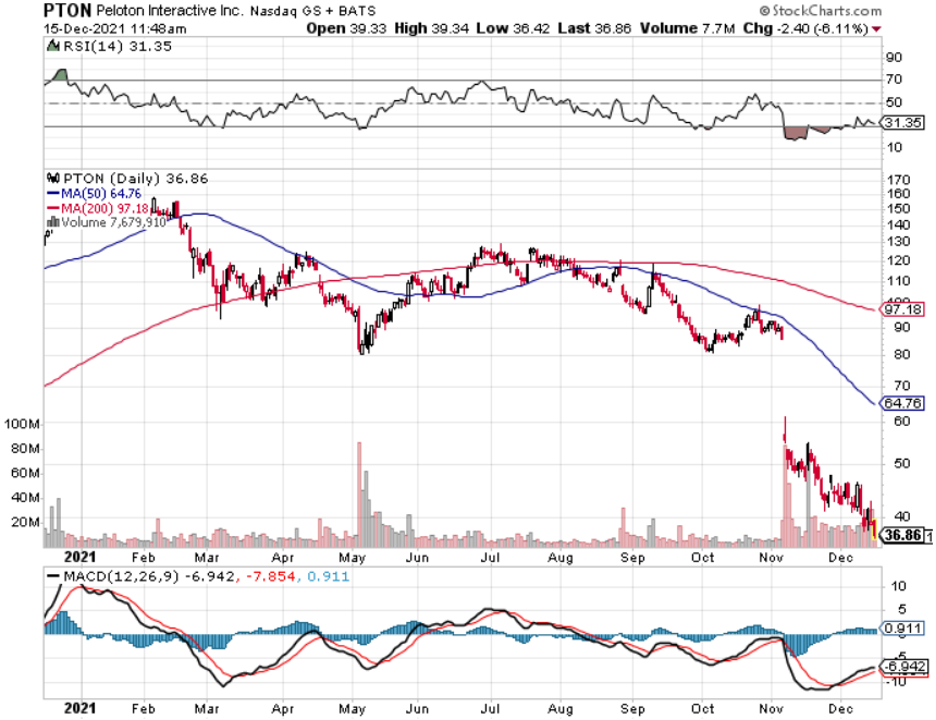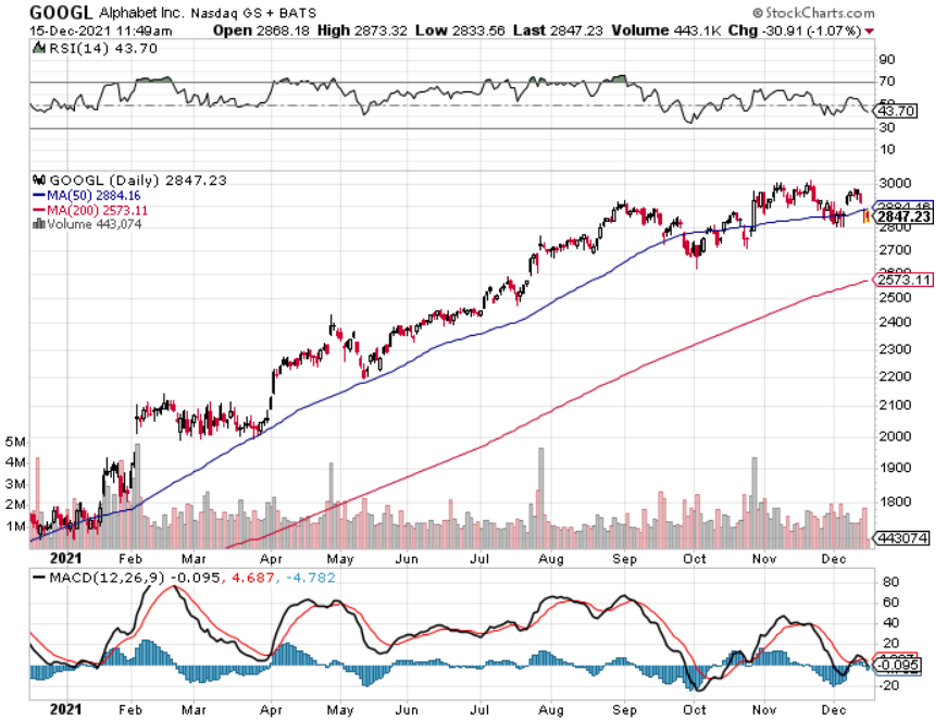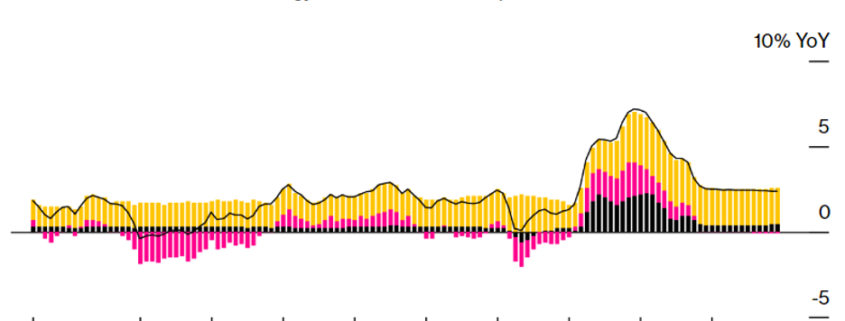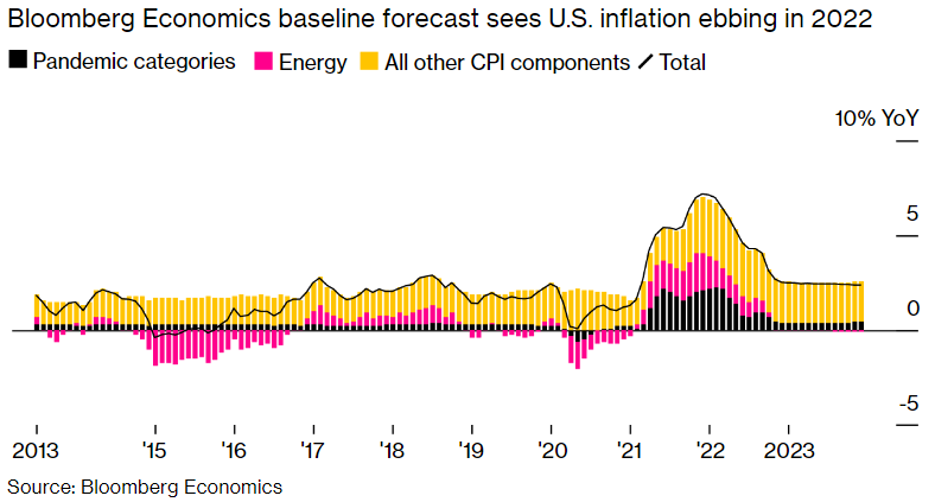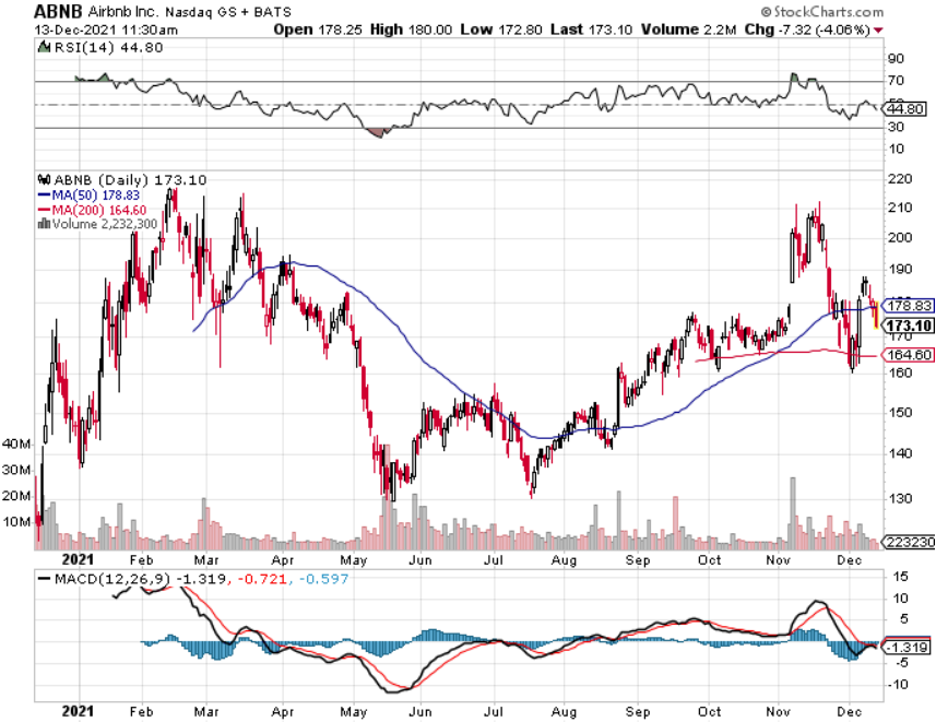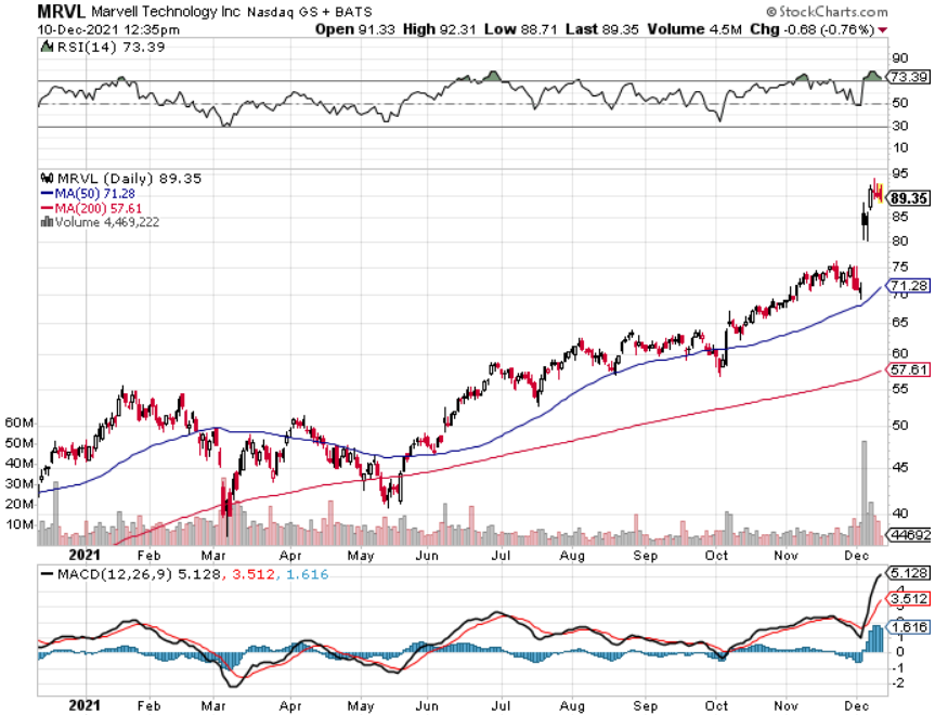“We want Google to be the third half of your brain.” – Said Co-Founder of Google Sergey Brin
Mad Hedge Technology Letter
December 15, 2021
Fiat Lux
Featured Trade:
(BUY THE DIP IS BEING CHALLENGED)
(PTON), (ROKU), (TSLA), (GOOGL), (FB), (DOCU), (TDOC)
Ominous signals have started to emerge in the short-term patterns of tech stocks over the past few weeks.
We have essentially traded a Santa Claus rally to sell the spiked peaks as inflation numbers have come in way too hot for anyone to handle.
The poor inflation numbers have triggered a cascade of algorithmic selling.
Why is this important?
These stock patterns will offer us clues to how tech stocks will react in a quickly changing backdrop where the Fed is backing away from the cheap money cauldron as fast as it can.
For over ten years now, as tech stocks have bulldozed their way to higher highs and as Apple inches closer to $2.9 trillion in market cap and on its way to $3 trillion, investors have been systematically conditioned to buy the dip.
The Fed is doing its best to recreate a new type of conditioning where the dip is not bought and that is awful for tech stock prognosticators.
This effectively means a large layer of buyers on down days will be stripped away from the tech markets.
Any idiot would understand this means that tech stocks will not go as high as they could if dip buying is conditioned.
The tech market is trying to figure out the new rules of the game and that is resulting in choppy patterns almost in whipsawing fashion.
March 2022 is the new consensus for an interest rate rise which is bad news for tech stocks because pulling forward interest rate rises coincides with higher volatility in the short term.
The Fed could make another interest rate move in the second half of 2022.
This means that anyone dallying in the speculative area of the tech market needs to pull the reigns in immediately.
Stocks like Peloton (PTON), essentially a stationary bike with a tablet pasted on the dashboard, will historically underperform in the new environment.
Another tech stock I love to bully is Pinterest (PINS), by far the worst social media platform I have ever seen, will need to face reality without the Fed punchbowl that was most likely their biggest tailwind.
Tech stocks must now stand on their two feet and that’s scary news for all tech stocks not named Tesla, Facebook, Apple, Amazon, Microsoft, and Google.
After these top 5, the quality dwindles fast and expect a slew of rapid downgrades that will throttle the non-elite software stocks.
Adobe’s stock had its second-worst day of the year on Tuesday, as analysts jumped on the higher rates bandwagon and cited high valuations.
Valuations are now “high” even if these business models are the same as they were a few days ago.
Expect poor guidance from management with earnings growth, free cash flow, and annual revenue downgrades in the pipeline.
Other notable sell-offs this week include shares of cybersecurity companies Zscaler and Cloudflare, which crumbled 7.8% and 9%, respectively.
Zscaler had been up 55% for the year, prior to Tuesday, and has an enterprise value to revenue multiple for 2022 of 39. Cloudflare was up 91% and trades at a multiple of 61.
Tech growth works both ways in which they get the benefit of the doubt in a low-rate environment and vice versa in a tightening environment.
Case in point is a company I really like Roku (ROKU) whose shares are down a hideous 230% since mid-July.
The weakness in the secondary names has been biggest secret untold in tech for quite a while and the confirmation of a tough 2022 was what happened in the first two weeks of December.
And it gets worse when looking at the shelter-at-home darlings of 2020 Teledoc (TDOC) and DocuSign (DOCU) who have been totally neglected this year.
This goes to show that every year is different and as the stock market is levered to the skies, the slightest nudge by the Fed does a lot to wobble the trajectory of tech.
Luckily, tech still has the 6 big tech stocks to rally around and even if the best of the rest must go into hibernation in 2022, we still got guys like Mark Zuckerberg, Tim Cook, Elon Musk powering us through the sludge.
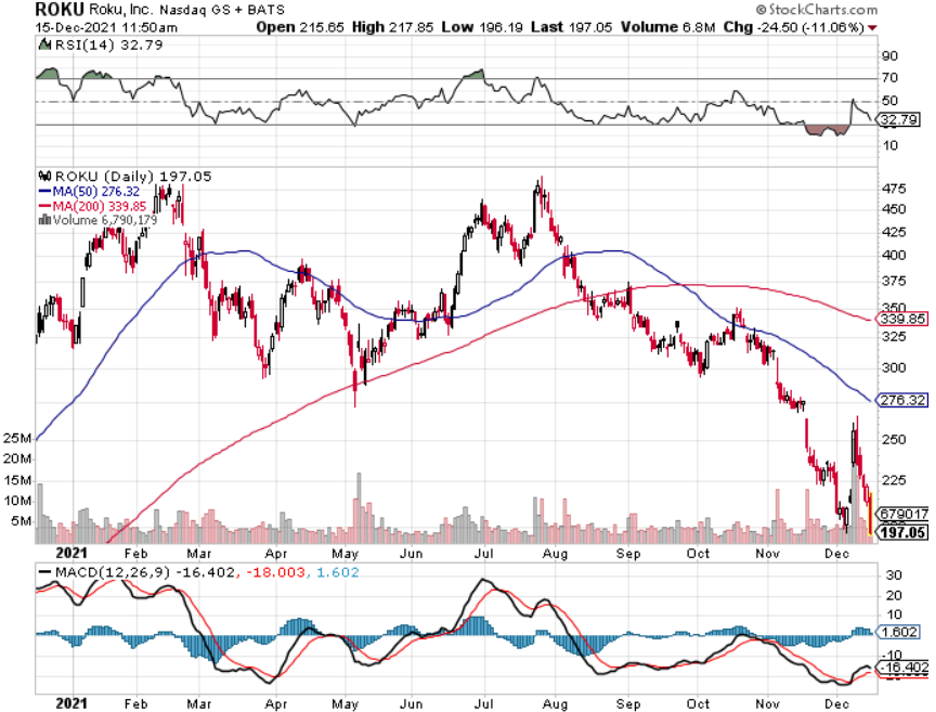
“The business model of social media companies, of pure advertising, is problematic. It turns out the huge winner is low-quality content.”– Said Founder of Wikipedia Jimmy Wales
Mad Hedge Technology Letter
December 13, 2021
Fiat Lux
Featured Trade:
(THE POTENTIAL NORMALIZATION OF 2022)
(ABNB), (BKNG), (ZM)
The last 2 years haven’t been a walk in the park for tech traders.
Before March 2020, the bull market and the trading patterns that followed were largely predictable.
Sure, there were our run-of-the-mill selloffs, but nothing like the Covid selloff of 2020.
Then the ensuing reversal that took us to new highs was a sugar high Fed-induced bounce that we are still buoying from, and that boost is largely wearing off.
As we near the end of 2021, it’s hard to believe that it’s been almost 2 years since the daily trading headline became a health care-driven headline.
There is the growing consensus that in the latter part of 2022, a synchronized global recovery story will emerge as the strongest plausible scenario.
This means that day-to-day business conditions which include international travel could revert back to what we had prior to March 2020 or a competing version of it.
I won’t get into the vaccine semantics of it, but a moderate health solution is only positive for tech stocks.
The “shelter at home” tech trade of 2020 was a one-off drawn-out event, and with normalization around the corner, we will return to the catalysts that originally drove tech shares — earnings growth, revenue growth, and financial engineering.
The lingering effects of this latest variant could start to wind down by early spring which will give way to the world of higher interest rates and costlier financing, but higher interest rates solving the inflation crisis.
Naturally, many things could side-swipe this scenario like another covid variant deadlier than the ones spreading around now.
If there is some iteration of normalization involved next year, a tech stock that will squarely harvest the gains from its strategic position at the intersection of the internet and remote working is accommodation sharing platform Airbnb (ABNB).
Airbnb will blast off from the biggest developing trend in the global economy today: workplace flexibility.
Like with Zoom (ZM) video conferencing tech making it possible to work from home. Airbnb makes it possible to physically work from any home, anywhere, and anytime.
While it’s not fair to draw a direct correlation from workplace flexibility to increasing Airbnb profits, it is clear that the company is poised to grow alongside the Web 3.0 revolution which will focus on decentralization, openness, and greater user utility.
As this new iteration of the internet takes hold and continues to spread, Airbnb's unique business structure will result in revenue produced from the sheer number of workers doing staycation remote working adventures.
This is a real thing.
Workers now go somewhere for a month then change their location to take in a different environment.
Riding this ongoing revolution and the steady reopening of global travel, Airbnb posted record revenue of $2.2 billion during its third quarter, which was 36% above Q3 2019.
If you want to look at the red-headed stepchild of the accommodation sharing platform services, then take a look at Booking.com (BKNG).
It’s not nearly as useful a platform as Airbnb and their exorbitant commission becomes quite prohibitive to hosts and users.
No wonder they do not grow their host volume like Airbnb.
Airbnb’s products also sell itself with the name of the company becoming a verb, while Booking.com is still reliant on spam-like internet searches using Google search to ramp up engagements.
This turns into an expensive marketing spend while Airbnb spends minimal to attract the next incremental customer.
ABNB shares have experienced a recent 20% pullback on the omicron threat, and I believe it’s a good time to start dollar cost averaging here into ABNB shares in the case that a bigger travel load 6 months from now follows through.
The upside to ABNB shares could be quite large if the business world somewhat normalizes next year because this scenario isn’t priced into ABNB shares yet.
“Broadcast TV is like the landline of 20 years ago.” – Said CEO and Founder of Netflix Reed Hastings
Mad Hedge Technology Letter
December 10, 2021
Fiat Lux
Featured Trade:
(AN EXPLOSIVE CHIP STOCK)
(MRVL), (FB)
One of the best semiconductor growth companies out there must be Marvell Technology, Inc. (MRVL).
Lately, performance has been clicking with revenue of 61% year over year.
And similar to the third quarter, MRVL is expecting another strong performance led by cloud customers across a broad range of products.
They expect data center revenue to more than double from a year ago, and project sequential growth in the double-digits on a percentage basis in the fourth quarter.
I am pleased with the strength of the cloud end market, which I expect will remain a strong driver of sustained growth for Marvell.
Looking out further in time, I believe there is immense potential for another phase of growth as large-scale virtual environments, such as Facebook (FB) is doing with their metaverse, start to gain traction.
In short, I expect many different implementations of virtual environments enabled by a broad set of companies and ecosystems that MRVL will be involved in.
Regardless of the form these environments take, the data sets will be exponentially larger compared to the current internet, which is largely two-dimensional, and latency will need to be extremely low to realistically simulate a real-world environment.
As a result, I expect the metaverse will significantly accelerate a number of key trends, which are already developing in the cloud today, including the need to store huge amounts of data in a secure environment, connected by high-speed electro-optic links to custom compute engines.
This next level of massive scaling makes the metaverse an even stronger candidate for cloud-optimized silicon solutions that Marvell is currently enabling.
This meshes perfectly with the core competencies MRVL has already developed across compute, storage, security, networking, high-speed electro-optics, and customization, which are driving their current success.
And these are equally applicable to the variety of virtual environments, which MRVL will develop over time.
The metaverse also has the potential to be a killer app for 5G, another area of strength for Marvell.
Multiple cloud customers have already engaged with MRVL, as they start designing the architecture of their next generation of data infrastructure to enable a significantly richer set of virtual applications and experiences.
Looking at the fourth quarter, I expect a strong ramp in MRVL’s 5G business of approximately 30% sequentially.
It's exciting to see MRVL step up in the 5G business, and I expect significant additional growth over the next several years as 5G adoption continues to grow around the globe, combined with Marvell content gains from designs.
Lastly, the future of technology in cars is all about electrification and intelligence, with embedded security and onboard storage in a fully networked environment.
Similar to the rise of optimized silicon and cloud, automotive OEMs are realizing that to differentiate their products and need unique technology and IP to be embedded in compute silicon optimized to their specific platforms.
In short, MRVL is at the intersection of growth and opportunity of every major technological innovation that carries weight.
From the metaverse, data center, and electric cars, their products are the heartbeat of how these technologies will evolve.
Buying this stock is a bet on technology accelerating which it surely will and long term, I don’t see how this stock isn’t up from today.
“I don't think of Apple as a stock. I think of it as our third business.” – Said Legendary U.S. Investor Warren Buffett
Legal Disclaimer
There is a very high degree of risk involved in trading. Past results are not indicative of future returns. MadHedgeFundTrader.com and all individuals affiliated with this site assume no responsibilities for your trading and investment results. The indicators, strategies, columns, articles and all other features are for educational purposes only and should not be construed as investment advice. Information for futures trading observations are obtained from sources believed to be reliable, but we do not warrant its completeness or accuracy, or warrant any results from the use of the information. Your use of the trading observations is entirely at your own risk and it is your sole responsibility to evaluate the accuracy, completeness and usefulness of the information. You must assess the risk of any trade with your broker and make your own independent decisions regarding any securities mentioned herein. Affiliates of MadHedgeFundTrader.com may have a position or effect transactions in the securities described herein (or options thereon) and/or otherwise employ trading strategies that may be consistent or inconsistent with the provided strategies.




